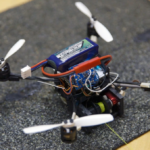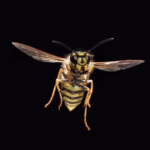Bio. Discoveries Translated into Devices: News, These Wasp-Like Drones Lift Heavy Loads With Their Bellies
A new class of robots, called FlyCroTugs, can lift objects 40 times their weight, using design ideas borrowed from wasps and geckos. You might know wasps for their ability to brainwash cockroaches or inflict one of the most painful stings on Earth—one so powerful that the actual scientific advice to victims is to just lie down and scream until it passes. Lesser-known is the wasp’s superlative ability to carry loads that are unexpectedly heavy given the creature’s size. Small drones, or “micro air vehicles,” are only able to lift the equivalent of their own weight. If we want flying robots that can move massive objects without requiring them to be the size of pterodactyls, engineers will need to come up with new ways of lifting stuff. So drone designers are looking to wasps for help, and developing creative ways to use the environment itself as a secret weapon in robotics. If a wasp stings and knocks out prey that’s too big for it to fly off with, the predator drags the thing away. It can do this using a structure on its feet called an arolium, a pad that helps them get a grip on a surface. Combined with claws on the feet, the arolium allows wasps to maneuver objects that they can’t outright fly away with. Which means they can punch—or sting—far above their weight class. Engineers want drones to do the same. So a new class of robots, known as FlyCroTugs, takes a cue from these feisty fliers. On the surface, they look like regular old quadrotors that would fit in your palm. But the secret is hidden away on their bellies. While sitting on the ground, one version of the machine uses hooks to snag bumps and pits to anchor itself to the surface like a wasp’s claws do, while another version uses a pad to stick to a smooth surface. The machines can then use a tiny winch to lift and drag things up to 40 times their own weight.
Learn about our two Decals!
 Click here to find out more about our Fall Bioinspired Design Decal and our Spring Bioinspired Design in Action Decal – ALL MAJORS are welcome.
Click here to find out more about our Fall Bioinspired Design Decal and our Spring Bioinspired Design in Action Decal – ALL MAJORS are welcome.Berkeley BioDesign Community
 Click here to learn about the BioD: Bio-Inspired Design @ Berkeley student organization or here to signup for more info.
Click here to learn about the BioD: Bio-Inspired Design @ Berkeley student organization or here to signup for more info.Search
Student Login





I imagine that the neurological circuits underlying these processes are governed by both 2d spacing maps with their brains as…
to reduce the impact of car accidents, it may be possible to study the force diverting physics of cockroaches to…
you see this type of head-bobbing stability in many avian creatures related to pigeons like chickens. the head ability to…
not like they taught horses how to run! this is an example of convergent evolution where both sea creatures and…
The brain functions in a similar way with neuronal connections. our brains are able to utilize the multiplicity of connections…